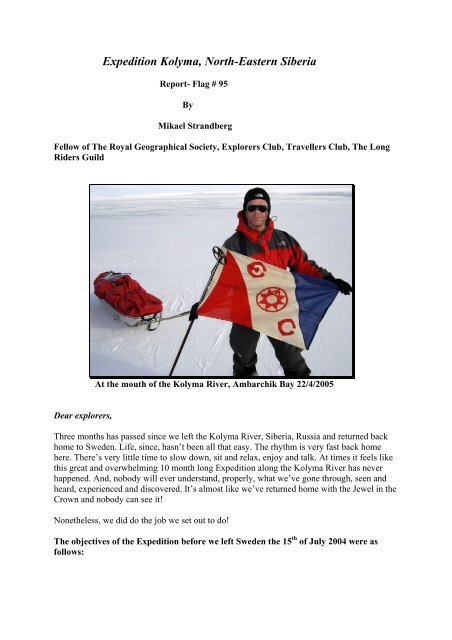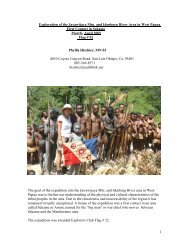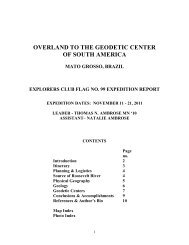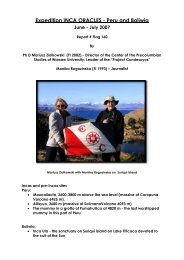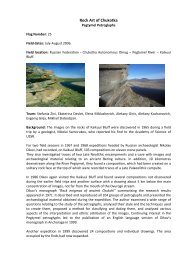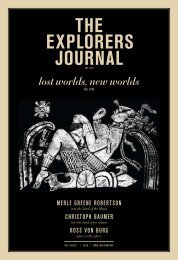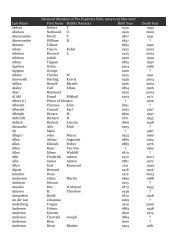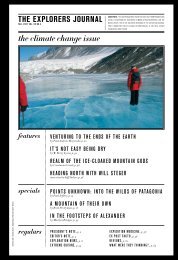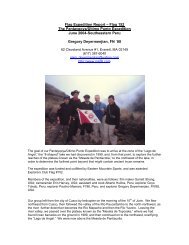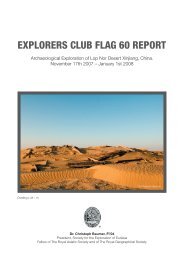Expedition Kolyma, North-Eastern Siberia - The Explorers Club
Expedition Kolyma, North-Eastern Siberia - The Explorers Club
Expedition Kolyma, North-Eastern Siberia - The Explorers Club
Create successful ePaper yourself
Turn your PDF publications into a flip-book with our unique Google optimized e-Paper software.
<strong>Expedition</strong> <strong>Kolyma</strong>, <strong>North</strong>-<strong>Eastern</strong> <strong>Siberia</strong><br />
Report- Flag # 95<br />
By<br />
Mikael Strandberg<br />
Fellow of <strong>The</strong> Royal Geographical Society, <strong>Explorers</strong> <strong>Club</strong>, Travellers <strong>Club</strong>, <strong>The</strong> Long<br />
Riders Guild<br />
At the mouth of the <strong>Kolyma</strong> River, Ambarchik Bay 22/4/2005<br />
Dear explorers,<br />
Three months has passed since we left the <strong>Kolyma</strong> River, <strong>Siberia</strong>, Russia and returned back<br />
home to Sweden. Life, since, hasn’t been all that easy. <strong>The</strong> rhythm is very fast back home<br />
here. <strong>The</strong>re’s very little time to slow down, sit and relax, enjoy and talk. At times it feels like<br />
this great and overwhelming 10 month long <strong>Expedition</strong> along the <strong>Kolyma</strong> River has never<br />
happened. And, nobody will ever understand, properly, what we’ve gone through, seen and<br />
heard, experienced and discovered. It’s almost like we’ve returned home with the Jewel in the<br />
Crown and nobody can see it!<br />
Nonetheless, we did do the job we set out to do!<br />
<strong>The</strong> objectives of the <strong>Expedition</strong> before we left Sweden the 15 th of July 2004 were as<br />
follows:
We are choosing to travel in this adventurous manner since we realise, after sixteen years of<br />
extreme expeditions all over the world, that the purpose of the journey cannot be achieved in<br />
any other way. <strong>The</strong> purpose is namely to document, in a down-to-earth, positive and fair<br />
manner, parts of our world that are unknown at the present time but very important for our<br />
future. It is, moreover, a means of travel that takes you up close to things in a manner that is<br />
non-aggressive, close to nature and, as a rule, healthy. As for the people we meet along the<br />
way, we have noticed that it is very easy for them to relate to the hardships we endure, since<br />
their daily life is usually governed by physical labour, the capriciousness of the forces of<br />
nature and the eternal hunt for food. This immediately enables us to gain admission to their<br />
lives.<br />
Mikael together with two legendary Yakut rathunters.<br />
<strong>The</strong> main aim is to use words and pictures to make a record of this unknown part of our<br />
world. This is a vital task, since in the course of our extensive research work we have realised<br />
that very few people have a comprehensive picture of the area along the <strong>Kolyma</strong> River. <strong>The</strong><br />
obstacles are the cold, the distance, the size and the isolation. <strong>The</strong> area is untouched, remote<br />
and unknown. We also believe that it is in this untouched area that the answers to many of the<br />
questions asked by modern men are to be found: What are we doing here? What is our task?<br />
How do we find calm, harmony and satisfaction in our lives?<br />
Making such a record is a task that is not only vital, but urgent. It concerns both the harmony<br />
and insight available to future generations as well as knowledge not only about this unique<br />
area of tundra and taiga that is as yet untouched, but also the equally unique people who live<br />
there. We shall do everything in our power to make a realistic record of how we and the<br />
people we meet experience the daily life and dreams of this area, but we will primarily focus<br />
on what is positive. We want our work not only to be educational, but also to inspire hope,<br />
motivation, energy and enormous joie de vivre! It goes without saying that there will be a<br />
large helping of excitement and adventure as well…
We shall also record the adventures and personal hardships we endure. <strong>The</strong>re is an evergrowing<br />
need for dreams, excitement and adventure. It is almost a prerequisite for feeling<br />
good nowadays. We shall therefore record how we three endure the cold, how we deal with<br />
the animals we meet, what we do about our various mishaps, how we cross pack ice and open<br />
water and how we survive day by day. That in it self will be a great adventure.<br />
We also feel it is important that during the course of our journey we should record how the<br />
original inhabitants of <strong>Siberia</strong> live, think and view the world around them and the future. How<br />
do they survive the extreme cold? <strong>The</strong>re is much knowledge to be gleaned from them.<br />
Another aim of this expedition is to build a bridge between our cultures, widen the western<br />
world’s knowledge about the Russian and <strong>Siberia</strong>n way. We want to find the Russian and<br />
<strong>Siberia</strong>n temperament. We believe this can provide a perspective on the way of life in the<br />
future.<br />
<strong>Expedition</strong> leader Mikael Strandberg with his assistant Johan Ivarsson<br />
Short summery of the <strong>Expedition</strong>:<br />
We travelled approximately 3500 km:s by canoe and skis during 10 months of exploration.<br />
We began canoeing in the beginning of August, in a tributary to the <strong>Kolyma</strong> River, a nasty<br />
river called Kulu and got hit immediately by a typhoon. <strong>The</strong> water level of the river rose 7<br />
metres in a couple of days, we didn’t sleep for a week and slogged our way through<br />
dangerous rapids and difficult currents for a month. Nevertheless, we eventually made it all<br />
the way to a small Russian settlement called Zyryanka, which we reached in the middle of<br />
October. We hunted and fished for survival all this time.
Mikael and Johan with Flag # 95 in -71°F.<br />
We left Zyryanka in the middle of November and skid, dragging 330 pounds of weight behind<br />
us each, in darkness and extreme cold, all the way up to our goal at Ambarchik Bay, which we<br />
reached at the end of April 2005.<br />
Map and route as below:
Accomplishments:<br />
-We’ve definitely done one of the coldest <strong>Expedition</strong>s in the history of exploration. We<br />
started freezing the 25 th of September 2004 and stopped once we climbed on the plane back to<br />
Moscow the 26 th of April 2005. Average cold during the darkest –and we mean pitch black,<br />
day and night, most of the time- was -54°F. During that time we skid between 12-16 hours a<br />
day, in total darkness, and we couldn’t really sleep during the nights in the tent, since we<br />
froze incredibly much. We hauled 330 pounds of heavy sledges per person behind us and<br />
every time we stopped, for a very short break or when it was time to pitch camp, all our sweat<br />
froze immediately. Under our armpits, our faces, the backbones and even the holy parts. It<br />
took the whole night to thaw of the ice of the body. So we kind of slept with bent backs. It<br />
was one long nightmare, dominated by a big discomfort, since we also had all our technical<br />
equipment and damp clothes inside the sleeping bags. It was so cold during this time, which<br />
all metals in our equipment broke like glass. Like our ski bindings. Petrol froze, so we<br />
couldn’t cook on the stove and we picked up plenty of frostbites.<br />
-We have done a serious documentation of how modern humans like us can cope with the<br />
cold compared to the hardy locals living along the <strong>Kolyma</strong>. One of the coldest inhabited<br />
regions in the world. And we‘ve discovered a lot of truths, that differ from the general picture<br />
painted by so called polar scientist’s who have never lived outdoors in a tent during the<br />
darkest of winter. And none seem to have monitored locals during a whole season.<br />
Withstanding cold definitely has nothing to do with genetics, it is just a question of<br />
acclimatisation.<br />
<strong>Siberia</strong>n Santa Claus<br />
For example, before leaving on this <strong>Expedition</strong>, I read all modern accounts of polar travel and<br />
we were stunned how many of them suffered from severe frostbites. I figured that was due to<br />
two reasons, one, they were not brought up in snow and cold. Two, they didn´t live<br />
permanently in a cold climate. Like all northern natives for example. And like ourselves, since<br />
we’re brought up and live like Bushmen in one of the coldest places in Scandinavia. As a
esult, even though we lived outdoors in a climate much more severe, and longer, than almost<br />
all other polar explorers, we didn’t suffer any serious frostbite.<br />
On top of that, there was the subject regarding fat. One very famous polar scientist told me,<br />
when I let him know that we´d added on almost 40 pounds of additional fat each on our<br />
bodies, to cope with the cold: “Have you ever seen a fat native?” I´d like to ask him: “Have<br />
you ever spent a whole season with a native trapper?” <strong>The</strong> reality is, that in November they all<br />
had a couple of extra layers of fat on their trained bodies, but once springtime arrived, they’d<br />
lost most of it due to insufficient amounts of food!<br />
-We have documented every little cottage and hut along the <strong>Kolyma</strong> and the great locals<br />
living there. We’ve documented their daily lives and thoughts.<br />
-We survived ourselves on 3 months of trapping, hunting and fishing. We didn’t carry any<br />
food during our canoeing part except salt, spices, cooking oil, coffee and flower. We showed<br />
that our skills as local Swedish trappers were good enough for survival during the autumn (we<br />
wouldn´t have coped with the extreme winter), even though we lost a lot of weight! We’ve<br />
eaten everything from fried moose brain to raw frozen fish.<br />
Swedish trappers along the <strong>Kolyma</strong><br />
-We’ve penetrated deeply into the native people’s daily life and history, like the Yugahirs,<br />
the Yakut, the Even, the Chukchi, the Evenk and the Caucasian Russians. We also know a lot<br />
about their spiritual life, their historical background and their thoughts of the future.<br />
-We have also come very close to a deep understanding regarding the dramatic changes<br />
due to the arrival of perestroika in the region and we’ve documented the opinions of the<br />
people. And seen the profound changes of their lives. Generally, for the worse.
Yakut cowboy riding the famous Yakut horse.<br />
-We’ve documented the survival and life of the Yakut horse, which the equestrian world<br />
thought was almost extinct.<br />
-We’ve also documented Stalin’s terrible history along the <strong>Kolyma</strong> in the form of ruined<br />
Gulags. We’ve met and documented survivors, their relatives and how their lives have turned<br />
out today.<br />
-We also sent a two language dispatch over satellite almost everyday. All together there are<br />
over 250 reports to be read and studied at www.siberia.nu from the <strong>Expedition</strong>. We´ve also<br />
sent TV-programmes over the satellite.<br />
-Most important, however, we´ve come across the best people I´ve met during almost 20<br />
years of exploration all over the world. I miss them deeply. Life will not be easy without<br />
them. I intensely miss just walking into a yurangi –a Chukchi reindeer cot- sit down on the<br />
comfortable skins on the ground, feel the heat from the stove and start talking about any given<br />
subject of the day. I have finally realised why we humans differ from the rest of the ape<br />
family, it is our form of communication! I have never felt as happy as when sitting for hours<br />
talking to people. Now, once back home in the west, it seems like we westerners are returning<br />
back to the rest of the family of the other apes. Communication here in the west is lousy and it<br />
is getting worse by the day!<br />
For in-depth information about the <strong>Expedition</strong>, visit www.siberia.nu
Members of the <strong>Expedition</strong>:<br />
<strong>Expedition</strong> leader<br />
Mikael Strandberg<br />
Sörberget 6 | SE-790 90 Särna | Sweden<br />
Phone/Fax +46.253.102.08 | Mobile +46.70.594.57.22<br />
info@strandberg.se | www.strandberg.se<br />
Project leader (Titti had to pull out of the <strong>Expedition</strong>, once we reached Magadan, due to heart<br />
failure)<br />
Titti Strandberg<br />
Sörberget 6 | SE-790 90 Särna | Sweden<br />
Phone/Fax +46.253.102.08 | Mobile +46.70.594.57.22<br />
info@strandberg.se | www.strandberg.se<br />
Assistant:<br />
Johan Ivarsson<br />
Östra Kyrkogatan 12 B, 822 30 ALFTA<br />
Phone +46 70-3904259<br />
johan@siberia.nu | www.siberia.nu<br />
<strong>The</strong> team before leaving Sweden, mid-July 2004


